Entrant Vision
Consider a three-card game where a face-up Ace, 2, and 3 are on offer, and you invite a friend to select any card. If she picks the Ace, you pick the 2 and say, "2 is bigger than 1, so I win." If she picks the 2, you pick the 3 and say, "3 is bigger than 2, so I win," and of course, if she picks the 3, you pick the Ace and say, "Ace beats a 3, so I win." Your friend wouldn't be too impressed, even if you only played one round of this game. If multiple rounds were played, she'd probably complain that you changed the rules as you went along. "The Ace can't be both high and low," she might well cry, "You can't have it both ways." And yet we do have it both ways when playing poker: both Ace, 2, 3, 4, 5, and 10, Jack, Queen, King, Ace are considered to be straights, examples of rare five-card hands.Wrap-arounds like that of course lead to cyclic arguments; the one above can be summarized as 1 < 2 < 3 < 1 < ... ad infinitum. Cycles are hardly a new concept in mathematics, though there is shock value in seeing them arise in the context of strict inequalities, as we are much more familiar with transitive relations than non-transitive or intransitive ones. Some well-known games exhibit cyclic logic: for instance, rock-paper-scissors. Surprisingly, the three-card swindle above is essentially what's at the heart of much more subtle paradoxes involving dice. We survey some of these before switching our attention to playing cards.
Non-transitive phenomena of this stype first came to the public's attention via Martin Gardner's "Mathematical Games" column in Scientific American, in December 1970. There, he discussed a set of four dice A, B,C, D, discovered by statistician Bradley Efron, for which which A > B > C > D > A ..., in the sense that each die beats the next one listed with probability 2/3. See chapter 22 of Martin's The Colossal Book of Mathematics (Norton, 2001), or Ivars Peterson's "Tricky Dice Revisited." As Gardner notes there, Karl Fulves published applications of the Efron dice to card effects as early as 1971. Gardner provides several other card incarnations.
Twisted Mortice
We're going to focus on sets of just three dice, for which the margin of victory is generally smaller. There are sets of three non-transitive dice close to ordinary dice for which the margin of victory is very small indeed, but we prefer to focus on those associated with English toy collector Tim Rowett of Grand Illusions. He suggests colored dice on which are the following numbers:Green = {2, 2, 2, 5, 5, 5},
Blue = {3, 3, 3, 3, 3, 6}.
The big surprise is that not only does Red beat Blue, on average, violating one's deeply ingrained expectations of transitivity, it does so by an even larger margin. Red in fact beats Blue 5 + 5 + 5 + 5 + 5 = 25 times out out 36, or about or about 69% of the time, on average. Hence we arrive at the circular conclusion:
The standard way to take advantage these dice is a game where you invite a friend to select any one of the dice, following which you pick another. Decide on a fixed number of throws, such as a dozen, and roll the two selected dice that number of times. If you've picked your die wisely, you should win more often than your friend. Of course, if she picks the Red die, you pick the Green, if she picks the Green you pick the Blue, whereas if she picks the Blue, you pick the Red.
Amusing Strength
For a terrific kicker, play this a few times over, finally revealing your secret technique, then invite your friend to try to beat you. This time, you offer to select your die first, then have her pick one to beat yours. Once it's clear that she has mastered the game, produce a second set of such dice, which she can inspect to verify is identical to the first set. Announce that you'll continue to go first, only this time each of you selects two dice of the same color. The pairs are rolled, over and over, and the totals of the numbers obtained by each of you is used to decide on the winner. The strategy she has just learned will backfire badly on her: If you start by selecting the two Green dice, she will confidently select the two Blue ones, only to find that on average she will lose. Astonishingly, the new cycle of victory reverses the former one:but
Red + Red > Green + Green > Blue + Blue > Red + Red > ...
Secondary Dice (Crayons Decide)
How might all of this work with cards, bearing in mind that a deck only has four cards of each value? The basic idea is to replace each die with a packet of six cards, from which one is randomly selected (with replacement) in between repeated shuffles.One possibility is to first double each of the values used for the dice, yielding even numbers from 2 to 12 inclusive, then bump a few of them up by 1 to cut down on excessive repetitions. This also neatly sidesteps the issue of whether Aces are low or high.
Green = {4, 4, 5, 10, 10, Jack},
Blue = {6, 6, 7, 7, 7, Queen}.
Start with three such face-down packets of six cards, and ask a new friend to pick one of the packets. You pick another one, remembering that Red < Green < Blue < Red < ... as before. The cards in each selected packet are thoroughly mixed and the rolling of dice is replaced by the random selection of one card for each of you from each packet. Record whose card has the highest value, replace the cards in their respective packets and mix them again, and continue. With ten or twelve rounds, you should come out ahead on average, as in the dice case.
Tawdry Codices
Here's another card incarnation with an additional element of randomization, based on some well-known "magic square" dice. Consider the columns of the 3x3 magic square as shown:9 5 1
4 3 8
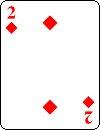
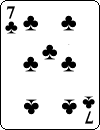
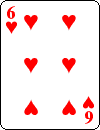
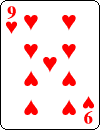

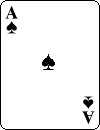
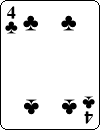
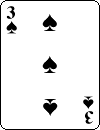
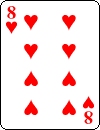
In practice, all dealing is done face down, and the columns overlap a little vertically facilitating order-preserving pickups. Now gather the three columns in any order–maintaining the card order within each column, and deal out again into three piles, from left to right. Repeat over and over, until the cards seem well mixed. Have a friend pick one column (pile) for himself, with or without first looking at the card faces. Turn the other two piles over so they are face up, and casually pick one of them for yourself. If you choose wisely, you will on average win in a game of "best of a dozen" as before, where this time the card packets have size three, simulating 3-sided dice. Once more, your guiding light is 1 < 2 < 3 < 1 < ...: Simply scan the six visible card faces for the Ace, 2, and 3. You will always see exactly two of those. The missing one is in your friend's pile, so pick for yourself the pile that's "bigger and better"—remembering that Aces are both low and high!
Why does this work? Certainly it's easy to check in the case when the three piles are {2, 9, 4}, {7, 5, 3}, {6, 1, 8}, as they are at the outset: then "Pile 2" (the one with the 2) beats "Pile 1" (the once with the Ace) about 56% (=5/9) of the time on average, and "Pile 3" beats "Pile 2" and "Pile 1" beats "Pile 3" by the same margin. This property of the columns of the standard 3x3 magic square (as displayed above) is well known, and is the basis for a set of corresponding non-transitive 6-sided dice where each of the three key values is used twice.
But what about the collection of the three columns in random order, in between repeated dealings from left to right? Since there are six (=3!) ways in which to gather the cards each time, one might expect as many possibilities for the resulting three piles. It turns out that there are in essence only two things that can happen. If the number of rounds of dealing and collecting is even, one ends up with something equivalent to the initial display, from the perspective of competing piles: the order in which the piles occur is irrelevant, as is the internal card order within each pile. For instance, after four or six rounds of dealing and collecting, one could end up with:









While not a conventional magic square, it retains enough magical charm for our purposes: It respects the partitioning of 1–9 into {1, 6, 8}, {2, 4, 9}, {3, 5, 7}, as does the result after any even number of rounds of dealing and collecting.
On the other hand, after any odd number of rounds of dealing and collecting, we get something like:









This is a representative of a class of equivalent arrays—the partitioning of 1–9 into {1, 4, 9}, {2, 6, 7}, {3, 4, 8}—which are in turn transposes of the kind we saw above after even numbers of rounds of dealing and collecting.
Even better, the 1 < 2 < 3 < 1 < ... mantra again holds here for the new "Pile 1," "Pile 2," and "Pile 3"! That's why the stunt suggested works no matter how many times the piles are dealt out and collected.
Indeed, the two partitions toggled between above are two of five existing for 1–9 that give rise to non-transitive dice, as documented in The On-Line Encyclopedia of Integer Sequences entry Sequence A121228.
There are many more variations on all of the above worth digging out. For instance, M. Oskar van Deventer came up with a set of seven dice such that for any two chosen dice there is a third one that beats them both.
"Recent Divinations" and "Card Intentions Vie" are two of many amusing anagrams of "Non-transitive Dice," and "Entrant Vision" (like "Star Invention") is an anagram of "Non-transitive." "Twisted Mortice" is an anagram of "Tim Rowett's Dice," and "Amusing Strength" is an anagram of "Strange Sum Thing." "Secondary Dice" and "Crayons Decide" are anagrams of "Dicey Cards One," and "Tawdry Codices" is an anagram of "Dicey Cards Two."
